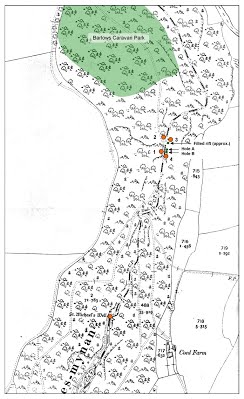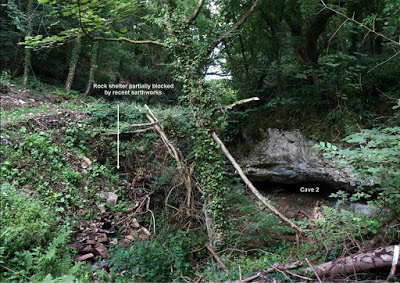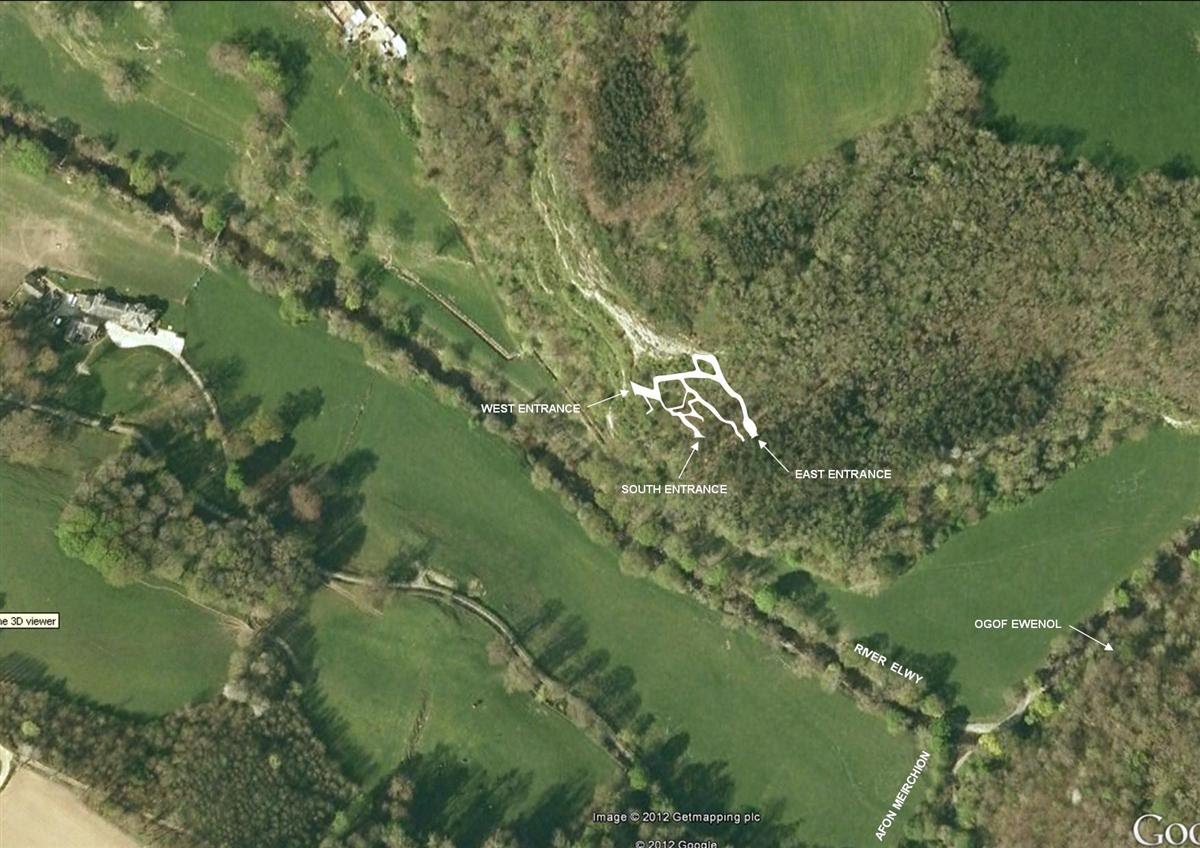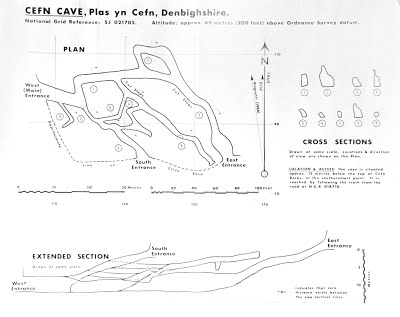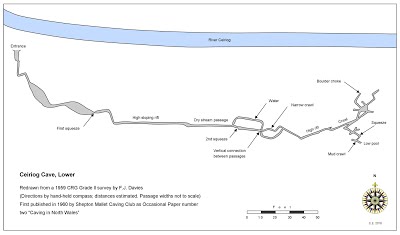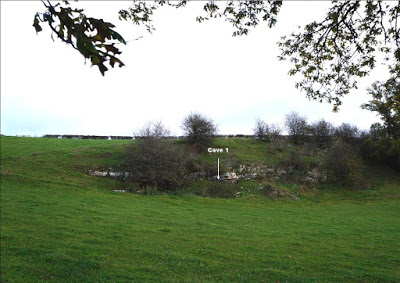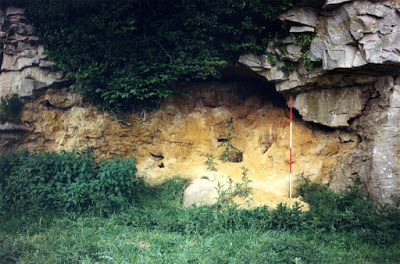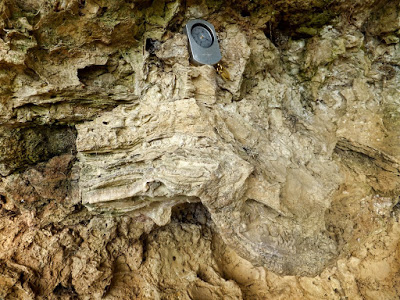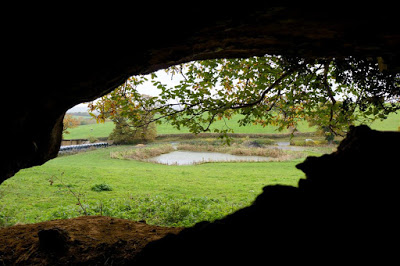Finds include arctic lemming, bear and human remains of Neolithic age. The glacial fill which blocks the cave contains 'abundant' blocks of speleothem (similar in nature to unexcavated deposits filling nearby Coppy Cave No 3).
Access: The cave lies within Cefn Estate belonging to Sir Watkin Williams Wynn and is therefore private property. Prior permission should be sought from the estate office at Cefn. Normally just a phone call in advance is required, then call in at the office on the day to sign a disclaimer.
The
cave is described in 'Neanderthals in Wales', as being 21m higher than
Pontnewydd Cave and 300m to the north. The writer of this website
remembers reaching it by climbing up 12m to the right of Pontnewydd Cave
entrance to a rough track. Follow the track to the left for 100-200m
and the entrance is off to the right about 10m above the track.
SMR: 19412
Excavation: H.S. Green, 1985
Curation: National Museum of Wales (86.32H)
Burials: 1+
Finds: None
Date: Neolithic (1)
14C: 3955 bp (OxA-5731) on human bone
Source:
http://caveburial.ubss.org.uk/wales/wales.htm
Aldhouse-Green, S. et al. (1996) Holocene humans at Pontnewydd and Cae Gronw caves. Antiquity 70: 444-447.
Stephen Green in Collcutt S.N. (1986) The Palaeolithic of Britain and its Nearest Neighbours: Recent Trends. Pages 36-42.
Caerwys Caves 1 – 4 Centre of area: SJ12377320 Caerwys
CLICK IMAGE TO ENLARGE
Location of caves and St Michael's W ell
The valley could repay close examination.
Access: Call at Barlows Caravan Park site office at SJ121736 for permission.
From the site office, drive south through the site for about 100m or so to a junction. Turn right here and follow this down to the bottom where there's a small car-park (at Fire Point 13). Park here then walk down into the woods following a rough track downhill for 200m to the dry valley where two paths converge.
Cave 1:
SJ1238173185 +/-30ft
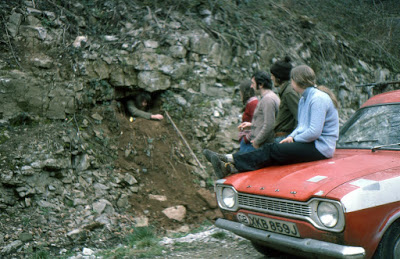
Cave 2:
SJ1236973200 +/-28ft
A south-facing entrance chamber-cum-rock-shelter 6m wide by 1m high. A passage leads off but is blocked by clay deposits.
Although Cave No 3 opposite appears to have been partially excavated at some time in the past, Cave No 2 appears to remain untouched. It could therefore be an ideal candidate for an archaeological test excavation.Cave 2
Cave 3:
SJ1238573201 +/-35ft
An entrance chamber 7m wide x 1m high x 7m+ long tapers down to a passage.
The passage was not explored in 2013, but appears to have been excavated.
Update:
A trial excavation in the floor of the entrance chamber, was carried out by Clwyd Powys Archaeological Trust in 2015 during which a human tooth was found in a layer containing ash charcoal. The tooth is 'an upper left canine with light to moderate wear. Root apex complete, therefore (the individual was) older than 12 - 13 years. Probably either an adolescent or an adult. Slight calculus deposits'
.
This charcoal proved to have a 'conventional radiocarbon age' of 4498 +/-29BP (SUERC-66490 [GU40396]).
Source: "CPAT Report No. 1380: Caves of North East Wales - Archaeological Evaluation 2015-16".
It is hoped that this small but important find will lead to further excavation work in the cave.
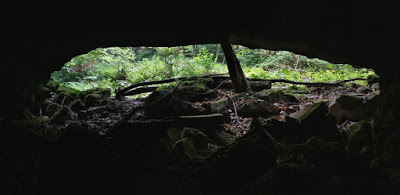
A fifth cave
existed in
1975. This was a 4m deep vertical rift excavated by cavers in the late
1960s. It lay a few metres due south of Cave 3. It was filled in by the
land-owners as it posed a risk to children staying at Barlows Caravan
Park and is no longer identifiable.
St. Michael's Well
Take the bridleway from Caerwys golf course to a corner at SJ12307251. Turn right by a stone post and follow a rough path through woodland just beyond the golf course fence. At Coed Farm, turn downhill through the trees to meet on obvious path below. Follow this down to river level. Walk upstream keeping to the river bank passing two mined chambers at SJ12237275 to the well beyond.
(Thanks to Dave Merchant for these directions)
First documented erroneously as Castell Mawr Caves in 'Caves of Wales and the Marches' (1963).
Named Castell Cawr Caves after the hill in which the caves are found.
Cave 1: A 15m crawl ends at a rift 5m high. The most northerly of the five, about 1m above quarry floor.
Cave 2: Small entrance chamber immediately lowers to a low crawl for 10m passing a blind rift to the left. The crawl opens out into a chamber 3m wide and up to 6m high. Gated by CCW to protect bat colony.
20m to the left of Cave 1, an awkward 6m climb up quarry face reveals the entrance.
Cave 3: A 3m rift passage blocked with clay. The lowest of the three. A short climb above quarry floor.
Cave 4: A rock shelter 3m across. The middle of the three being 6m below Cave 5.
Cave 5: A 5m passage becomes blocked with clay. There are two entrances. The highest of the three.
Cefn Cave Length 220m SJ0202970556 +/-10ft. River Elwy Archaeological (human)
Earliest finds Include: hominin, mammoth, hippo, cave bear, lion (Chesters Grosvenor Museum holds 121 items including bear, rhino, lion, mammoth, hippo, reindeer and hyena).
Designated a Scheduled Ancient Monument in 1923, Ref. DE115.
The designated area encompasses Cefn Cave's three entrances and Old Cefn Cave, the large cave and natural arch close to river level below Cefn Cave (see alphabetical entry for 'Cefn Cave, Old' below).
Cefn Cave (shown in white), based on the survey below
Three entrances give access to a series of roomy walking-sized passages. Two sets of stone steps have been created within the cave providing easier access to the higher entrances.
Much of the cave was cleared of infill in the search for bones from 1830 onwards
. The deposits were so rich in bone that for a while, they were excavated and scattered on the fields below, simply as fertiliser!
Finds include, hominin, mammoth, hippo, cave bear, lion and also flint flakes, worked antler and pottery. The National Museum of Wales carried out small-scale work at the cave in 1982-84. The oldest floor deposits have been dated to nearly 230,000 years (see also Pontnewydd Cave nearby).
The lower speleothem floor was dated by the National Museum of Wales (during the Pontnewydd Cave project) as being 240,000 years of age.
Source: Stephen Green in Collcutt S.N. (1986) The Palaeolithic of Britain and its Nearest Neighbours: Recent Trends. Pages 36-42.
Chronology of excavation and notable visitors to either Cefn Cave or Old Cefn Cave:
1750 (approx.) a mysterious hermit lived in the cave when the passage only extended a distance into the hillside of 20 feet. The rest of the cave, now known to extend a further 500 feet, remained filled with deposits.
1801 Richard Fenton describes (in his diary of 1808), when he discovered animal remains "....... and, from their form, some that must have belonged to animals now unknown; and quantities of stag horns of a great age with marks of their having been hacked with an edged tool, and some half burned, with quantities of charcoal". Four stone tools found in the cave were also probably found by Fenton, being described by Edward Stanley in a letter of 1832.
1830 Edward Lloyd of Cefn. As landowner at that
time, Lloyd began excavating at the cave and created a series of walks through
the surrounding area. He also constructed sets of stone stairs within the cave
connecting its (then) two entrances.
Lloyd describes rhinoceros remains "in the mud for the taking".
1831 Charles Darwin visited the cave at the age of 22 as part of a geological tour accompanied by the most respected geologist Professor Adam Sedgwick. On their visit Sedgwick noticed rhinoceros remains. Later that same year, he embarked upon his famous passage aboard the Beagle.
1832-33 The Reverend Edward Stanley having heard of the cave deposits being used as fertiliser, searched the field below and found a number of bones lying on the surface. These were sent to Professor William Buckland at Oxford for identification.
1836 William Bowman visited and remarked on the various sedimentary beds within the cave.
1838 Joshua Trimmer: One of the earliest people interested in sequencing of sediments. "The caves thus began to play a part in the contemporary debates being waged at the Geological Society in London and in publications about theories of the origins of deposits on the Earth".
1863 the cave was visited by Sir Charles Lyell with Lady Lyell and W.S. Symonds.
1866 T.J. Moore of Liverpool Museum and others excavated. Their finds included "teeth and bones of cave bear". Sadly they were never fully described and were destroyed at the museum during an incendiary fire of 1941.
1869-70 Mr Williams Wynne excavated and found further remains, some of which were given to the Grosvenor Museum in Chester.
1870 marked the first of nine visits by Boyd Dawkins up to 1877. After a visit in 1874 he records finding crumbling bone "that rose in clouds of dust as it was disturbed". Much of his time during the visits was however not spent at the caves, but at a Neolithic tomb elsewhere on the estate.
1872 W. S. Symonds visited the cave.
1887 G.H. Morton visited to investigate the deposits. He was interested in the similarities between species found here and at the nearby Ffynnon Bueno and Cae Gwyn Caves at Tremeirchion, such as elephant and hippopotamus. His collection including five hyaena teeth from Cefn Cave are now in the World Museum, Liverpool.
1923 Cefn Cave was designated as Scheduled Ancient Monument.
1952 The popularity of the cave was such that guides were provided to lead visitors through the cave.
1982-84 Excavations carried out by Stephen Green and others for the National Museum of Wales.
Source for chronology: Neanderthals in Wales (2012)
For a detailed bibliography, see: http://caveburial.ubss.org.uk/wales/cefncaves.htm
Access: The gorge forms part of Cefn Estate belonging to Sir Watkin Williams Wynn and is therefore on private property. Prior permission should be sought from the estate office at Cefn. Normally just a phone call in advance is required, then call in at the office on the day to sign a disclaimer and ask for directions to the cave.
Closer to river level, below Cefn Cave is Old Cefn Cave, a high natural arch. An archaeological cave exists in one wall of this arch (see Old Cefn Cave below).
Archaeological:
SMR: 19306, 102135, 102136
SAM: De 115
Excavation: J. Trimmer & E. Stanley, 1830-32; T.J. Moore et al., 1866; W.B. Dawkins, 1872; H.S. Green, 1982-84
Curation: Chester Museum; Liverpool Museum; National Museum of Wales, Cardiff (66.88/4-7, 68.88, 83.108H, 92.224H)
Burials: 1+
Finds: Pottery, flint flakes, worked antler, animal bones
Date: ? Neolithic (3)
Human bone was carbon dated to 2835bp (OxA-6233) and 1445bp (OxA-6234).
Source: http://caveburial.ubss.org.uk/wales/wales.htm
Grosvenor Museum in Chester hold 363 bones from Cae Gwyn, Cefn and Plas Heaton Caves: http://www.cheshirewestandchester.gov.uk/default.aspx?page=11306
They have kindly granted consent to reproduce the following images from their collection.....
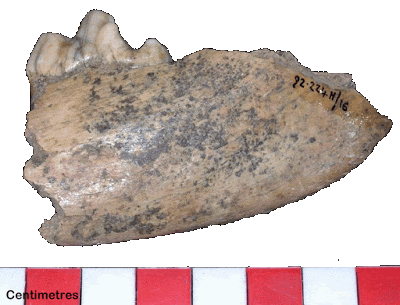
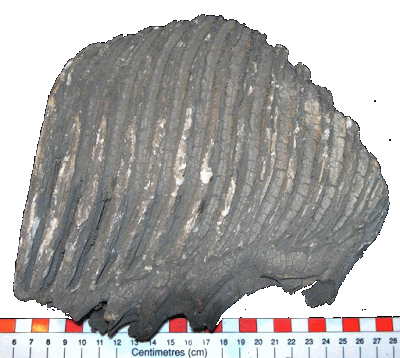
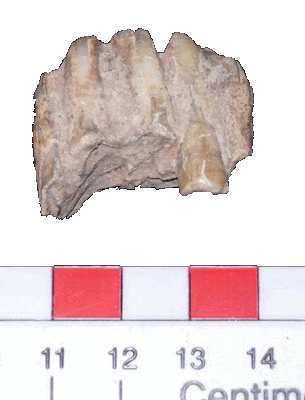
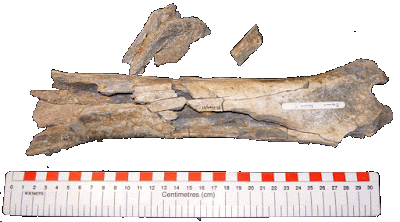

The small tube passage visible in the right-hand wall runs for a few feet to a right angle bend to
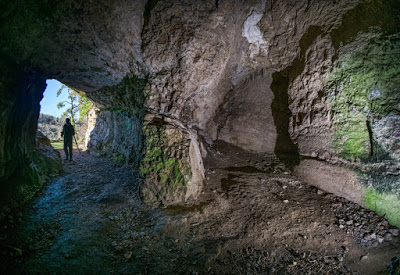
West entrance
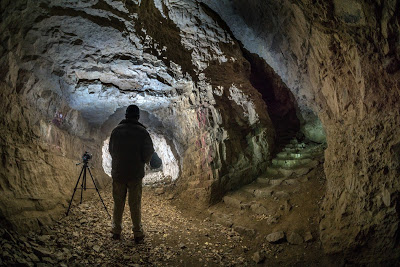
---------------------------------------------------------------------------------------------------------------------------------
Cefn
Cave, Old
Length: 30m SJ0202170460 +/-45ft River Elwy Archaeological (animal only?)
Designated a Scheduled Ancient Monument No. DE115 (which also includes Cefn Cave)
A 30m long passage forms a large natural arch (10m high x 2.5m wide), through which the old St.Asaph to Denbigh road once passed.
At floor level near the west entrance is a small descending passage which opens in the rock face below.
At the east entrance is a large rock shelter containing a blocked passage where the first archaeological finds were made.
This cave is perhaps the earliest recorded excavation producing ancient remains in Wales. Richard Fenton describes h is work of 1801 in his diary of 1808. During this 1801 visit he discovered remains of small animals "....... and, from their form, some that must have belonged to animals now unknown; and quantities of stag horns of a great age with marks of their having been hacked with an edged tool, and some half burned, with quantities of charcoal" (Source: Neanderthals in Wales 2012).
Reverend Edward Stanley subsequently excavated in 1833, when he referred to the site as 'Cefn Cave'. This later led to confusion after the discovery of archaeological remains in the more extensive cave above which also became known as Cefn Cave. To clarify this confusion, the National Museum of Wales decided that the lower cave (the natural arch) would be known as Old Cefn Cave, whilst the cave above would be Cefn Cave. Source: Neanderthals in Wales (2012).
Access:
Old Cefn Cave
can be found 10 metres above river level some 20 or 30 metres below Cefn Cave. It
lies within Cefn Estate belonging to Sir Watkin Williams Wynn and
is therefore on private property. Prior permission should be sought
from the estate office at Cefn. Normally just a phone call in advance is
required, then call in at the office on the day to sign a disclaimer.








---------------------------------------------------------------------------------------------------------------------------------
Ceiriog Cave, Lower Length 155m SJ2654437472 +/-16ft Chirk
An early account describes the cave as follows:
“E.A.P. writing in the Liverpool Daily Post & Mercury for 1905 gives an interesting account of his exploration of a cave in the Ceiriog Valley. The cave, it was reputed, extended over 6 miles in the direction of Oswestry, but the furthest reached was little over 500 feet in all. The cave mouth is about 20ft. above the river in a cliff facing due north, in which the limestone is tilted at an angle of 45 degrees. After two or three bends, the roof as well as the floor rises and the passage opens into a chamber about 20ft. by 20ft., and turns south-east, and then a second chamber widens out, 50ft. long by 6ft. broad. Rising 10ft. the passage continues to the east-south-east; the walls converge, and then it opens out again and becomes loftier but narrower. Nearer the cave mouth, matches and candle grease and the marks of crawling were plentiful, local adventurers having got in nearly 100ft.. Pushing on, the explorer found himself in another horizontal tunnel, and presently emerged into an open passage 25 – 30ft. high, which led him out through a parallel passage, which, however, had to be cleared out of big stones. On a second visit the explorer and a friend penetrated to a small chamber with four exits, each of which they explored. Every branch led eventually to other points of divergence, and ultimately to small tunnels or pipes, through which the water flowed in rainy weather into the head of the cavern. There were numberless chinks and fissures, all very interesting as a concise example of the whole history of the formation of a cave, but the furthest point reached was, by measurement, only a little more than 500ft. from the entrance. There were only in places stalagmite curtains on the walls and small stalactites, and patches of white amorphous tufa. Curious filaments of cave weed, white and brown, without a vestige of leaves, abounded throughout the cavern. Not far above the cave mouth he came across the exit of the water, a beautiful spring, pouring down into the Ceiriog a few yards away. Source: “By-gones” Jan 3rd 1906".
The text was taken from “A General Reference to the Caving Areas of North Wales” 1961, Derbyshire Caving Club, Bulletin No.1.
From Chirk high street, take the B4500 alongside the River Ceiriog for 1.9 miles, then take the lane on the left (Castle Mill) for 250 metres to a junction. Park on the left here, and look for a rather vague track at a gap in the verge, at this junction (see photo).
Follow the steeply descending route in the Chirk direction for 200 paces to the cave entrance.
Entrance viewed looking downstream
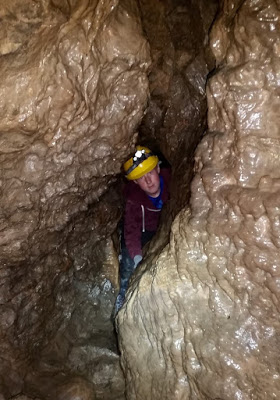
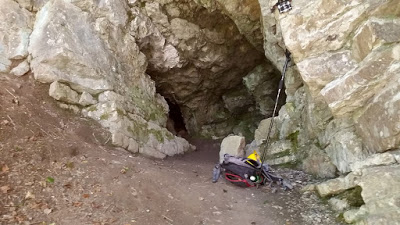
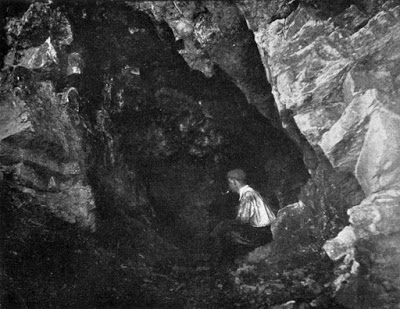
viewed looking towards the cave.
--------------------------------------------------------------------------------------------------------------------------------------------------
Ceiriog Cave, Upper Length 53m SJ250367 (approx.) Chirk
Cave is no longer open. Its description (with 1905 photo) has therefore been moved to Page 14: Lost & Non-caves
---------------------------------------------------------------------------------------------------------------------------------------------------
